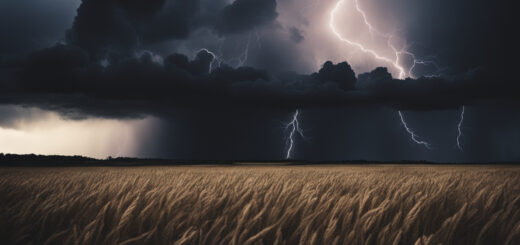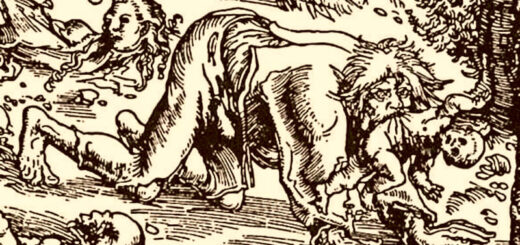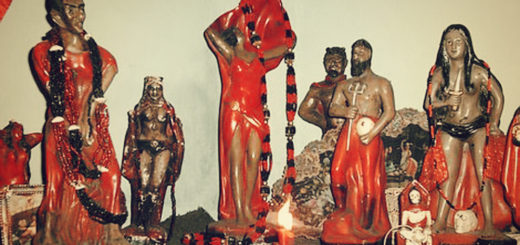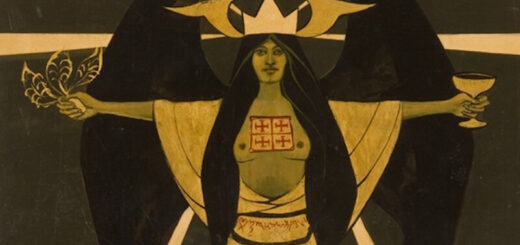The mystery of the White Ladies
White Ladies is a common term applied to apparitions of various natures, with the appearances of ghostly white ladies. They may be supernatural entities playing the roles of fairies, witches, night washerwomen or harbingers of impending death, or they may be the ghosts of deceased women when they are specters haunting castles or even ghostly hitchhikers. Legends of the White Ladies can be found throughout Europe and throughout the ages. In popular medieval legend, a White Lady is fabled to appear by day as well as by night in a house in which a family member is soon to die. In our time they also appear within photos just before or after death.
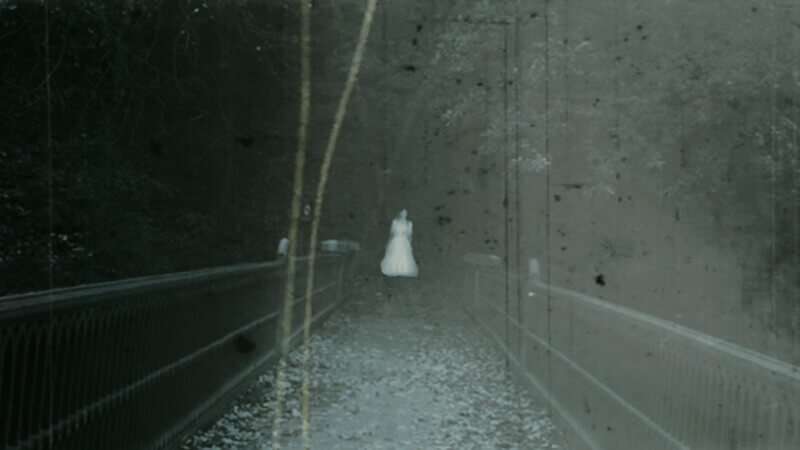
Artistic impression of a White Lady on a bridge.
There are many legends in which the Lady in White appears as the ghost of a woman who had lived too difficult or cruel a life. For example, in Czech legends and oral traditions, the specter is dressed in white, yet she always wears a hennin (a female headdress in the shape of a cone, bell or truncated cone worn in the late Middle Ages by European noblewomen) on her head. Sometimes the White Lady as a Banshee-like ghost of a woman merges with a figure from German folk-mythology like Perchta or a weather phenomena like the ghostly looking ground-fog as is often the case with the Dutch Witte Wieven.
White Ladies in Wales and England
In Welsh tradition, Y Ladi Wen (“The White Lady”) or Dynes Mewn Gwyn (“Woman in white”) is a common apparition in the Celtic Mythology of Wales. Dressed in white, and most common at Calan Gaeaf (the Welsh Halloween), she was often evoked to warn children about bad behaviour. Y Ladi Wen is characterized in various ways including being a terrifying ghost who may ask for help if you speak to her. Y Ladi Wen is also associated with restless spirits guarding hidden treasures.
In England there are over a dozen tales which portray the White Lady as a victim of murder or suicide who died before she could tell anyone the location of some hidden treasure.

Tombstone of Kunigunde von Orlamünde in der St.-Laurentius-Kirche in Großgründlach, a famous German White Lady
White Ladies in other European countries
In Switserland a popular legend has been associated for centuries with the ruins of Rouelbeau Castle in today’s municipality of Meinier in the canton of Geneva. It centers around a woman without a name, supposedly the first wife of the knight Humbert de Choulex, under whose leadership the castle was constructed in a swampy area at the beginning of the 14th century. He reportedly repudiated her when she did not give birth to a son. The ghost has been linked to the disappearance of people and deaths from unexplained causes.
“The Maidens of Uley” is an East Siberian legend of the west Buryad people from the village of Ulei, Irkutsk Oblast, Russia. The legend tells about a young lady, Bulzhuuhai Duuhai, who did not want to marry. She kept running away from her husband, who treated her disrespectfully and locked her in a black yurt, instead of a traditional white one. Bulzhuuhai then hanged herself in a barn after singing and dancing at someone else’s wedding for eight days and eight nights, feeling unwanted and unloved. After her death, she became a zayan (spirit). She joined other spirit maidens, who haunt fiancés on their wedding day, bewitching them with their beauty and dragging them to the netherworld.
Den Hvite dame (“the White Lady”) at Utstein Kloster (Utstein Abbey) in Stavanger Norway, is a White Lady that haunts the former abby. She is the ghost of Cecilie Widding Garmann (1734–1759), who died in child birth. Her husband is said to have promised never to remarry, but 20 years later he did. During the wedding in Stavanger Cathedral, he claimed to see Cecilie, fell into coma and died a week later. Today, Cecilie is claimed to be the ghost of the monastery, called Den Hvite dame.
In Hungarian mythology, a White Lady was the ghost of a girl or young woman that died violently; usually, young women who committed suicide, were murdered, or died while imprisoned. The ghost is usually bound to a specific location and is often identified as a specific person (i.e. Elizabeth Báthory).
The most famous White Lady of Estonia is said to reside in Haapsalu Castle. According to the legend, a canon fell in love with her, so she hid in the castle disguised as a choir boy, but she was discovered when the Bishop of Ösel-Wiek visited Haapsalu and subsequently immured in the wall of the chapel for her crime. To this day, she is said to look out of the Baptistery’s window and grieve for her beloved man. According to legend, she can be seen on clear August full-moon nights.
White Ladies attached to families

The best-known White Lady of the Czech Republic is the ghost of Perchta of Rožmberk at Rožmberk Castle.
White Ladies related to important families and acting in a Banshee-like way once were such a common phenomena on the European mainland that even the humanist philosopher Desiderius Erasmus wrote: “One of the most famous facts remains the appearance of the White Lady to the princely families.”
At the beginning of the sixteenth century, many great European aristocratic families had their own White Lady. More stylish than their ancestors, they did not scream and could even be protective, such as the White Lady of Krumlov, attached to the powerful Rožmberk (Rosenberg) family of Bohemia, who appeared several times in 1539 to the newborn heir.
The White Lady attached to the Germanic house of Neuhaus is ambivalent; she announces a death if she wears black gloves, but also a good omen if her gloves are white. We find White Ladies attached to the Habsburgs, the Hohenzollerns, the Brunswicks, the Brandenburgs, the Baden, the Pernsteins.
A white lady also appeared to Emperor Charles V in 1558, on the eve of his death, in the monastery of Yuste where he had retired. This white lady is the origin of the character of the Bloody Nun.
The double appearance of a white lady to Prince Louis-Ferdinand of Prussia, the day before and the day of his tragic death on the battlefield of Saalfeld, was witnessed by Count Gregory Nortiz, who, Prussian by origin, passed in 1813 to the service of Russia and died in 1838 as aide-de-camp to the Czar Nicholas. Count Nortiz wrote an account a few hours after the event at the castle of the Duke of Schwarzburg-Rudolstadt on October 9, 1806, around midnight, which is preserved in the archives of the House of Hohenzollern. In July 1832, it is to the Aiglon, son of Napoleon I, that she appeared the day before his death. In November 1835, while the Prince of Montfort was residing in Stuttgart with his uncle King William I of Württemberg, a white lady appeared in a gallery of the old castle, announcing by her presence the imminence of a death. The omen, reported by sentries, was taken seriously by the king, who was concerned for his sister, Princess Catherine of Wurtemberg, mother of the Prince of Montfort. She died in Lausanne on November 29, 1835.
This same white lady, whom tradition presented as the spectre of a mad infanticide, had already appeared in 1819 on the eve of the death of Catherine Pavlovna of Russia, the second wife of King William.
In 1889, a servant reportedly saw a white lady prowling in the park of Mayerling on the night of the famous drama. During her stay in Caux, near Montreux, the Empress Sissi claimed on August 30, 1898, to have seen the white lady clearly at night, 11 days before her assassination in Geneva.
also via: Barnes and Noble
Witte Wieven and Weiße Frauen
In Lower Saxon folklore Witte Wieven (eastern and northern parts of the Netherlands) or Weiße Frauen (northern Germany), are local mythical varieties on the White Lady-theme. In the Netherlands they are also known as Witte Juffers (White Maidens), Joffers, Jomfers, Widde Juffers, Juvvers, Wiefkes, Olde Witten, Guede holden or Telewitten. Het Moerasvrouwtje (the Swamp Lady) has overlap with the Witte Wieven. She is a creature found in folk tales and fairy tales. The swamp lady brews the vapors and mists above the swamp. She rules the underworld and is a kind of witch or sorceress and the aunt of the elves. She lures people to her swamp.
Witte Wieven can have a benevolent and malevolent nature. Often related with witches and/or ghosts, they show many similarities with the Banshee, the Fairy, and the E lf. Understood as malevolent beings, they abduct or switch newborns, abduct women, and punish people who have mistreated them. As benevolent beings, they may aid in childbirth or offer good advice. Indeed, though the adjective wit means ‘white,’ it may originally refer to the Germanic word wid, related to English ‘wit’ and ‘wise,’ and so might be better understood as ‘wise women,’ as they are known in Germany, where they are connected to the Völva.

Wit Wief leaving her tumuli. In the Netherlands people believed White Ladies (Witte Wieven) lived in ancient funeral mounts. It is an interesting fact that paranormal sightings more than average occur at crossings of ley-lines as several parapsychologists and dowsers have understated. Most tumili in the northern Netherlands are build on ley line vortexes. So people seeing apparitions at these locations and adopting the belief that White Ladies lived in these artificial hills is not that strange.
The belief in witte wieven (white wives) may have its origins in Germanic times, although we don’t know for sure. Similar phenomena in popular belief can be found in Indo-Germanic cultural areas, including Romanic languages and Gaelic. Megalithic monuments such as long graves, burial mounds (tumuli) and dolmens (hunnebedden in Dutch) were considered by some to be their home towns. The burial mounds often lie together with three and are also called ‘wievenbelter’. Witte Wieven were sometimes regarded as the spirits of witches or as other women who had done evil. At night they would slowly leave their mounts floating over the fields. In some sagas, Witte Wieven are fairies that appear as white mists on heathland and marshlands. They seduce people to follow them, with the result that these people disappear forever. The Witte Wieven dance over the heath or in the woods, have stored their money in megaliths and know exactly where valuables are hidden in the woods. Ghostly looking wisps of ground mist and fog banks are sometimes called Witte Wieven.
The ancient origins of the belief in Weiße Frauen

Den Hvite dame (“the White Lady”) at Utstein Kloster Stavanger Norway is the ghost of Cecilie Widding Garmann (1734–1759)
In German folklore, the Weiße Frauen (meaning White Women) are elven-like spirits that may have derived from Germanic paganism in the form of legends of light elves (Old Norse: Ljósálfar). The Dutch Witte Wieven went at least as far back as the 7th century. They are described as beautiful and enchanted creatures who not only appear at dusk but also at noon and can be seen sitting in the sunshine brushing their hair or bathing in a brook.
The association of Weiße Frauen with the color white and their appearance in sunlight is thought by Jacob Grimm to stem from the original Old Norse and Teutonic mythology of Alven (“Elves”), specifically the bright Ljósálfar. These “light elves” lived in Álfheim (part of heaven) under the fertility god Freyr. As mythology evolved, Elves no longer lived in Álfheim but lived on earth in nature.
The Weiße Frauen also may represent ancient beliefs in ancestral spirits or older native goddesses and nature spirits. Jacob Grimm noted in particular they might come from Holda, “Berhta, white by her very name” and Ostara. According to Grimm’s Teutonic Mythology and to the Mythology of All Races Series, the enchantment under which they suffer “may be a symbol of the ban laid by Christianity on the divinities of the older faith.” Similar in name to the Witte Wieven of Dutch mythology, the Weiße Frauen may have come from the Germanic belief in Disen or Land wights and Alven. There are also many legends in German folklore regarding Weiße Frauen, which are actually equivalent to the legends of White Ladies; ghosts of the United Kingdom. In the alpine Regions of Austria and Southern Germany they are called Salige Frauen, Salige, Salkweiber or Salaweiber.
Dames Blanches, the White Ladies of France
Dames Blanches in general were female spirits or supernatural beings, comparable to the White Women of both Dutch (Witte Wieven) and Germanic (Weiße Frauen) mythology. Dames blanches were reported in the region of Lorraine (Lotharingen) and Normandy. They appear (as Damas blancas, in Occitan), in the Pyrenees mountains, where they were supposed to appear near caves and caverns. Sometimes Dame Blanches act as the French version of the Irish Banshee, as a family-attached female ghost who only appears to herald the death of a family member.

What is said to be a real photograph of a Dame Blanche
In the Pyrenean legend, one finds Dame Blanches, related to people of royal or princely blood (or their spectres), who play a protective role. This is the case in Andorra, where a Dame blanche appeared near the waterfall of Auvinyà. She lived in a nearby tower and appeared several times to defend the Andorran territory against the aims of a bishop of Urgel, then against the attacks of a monstrous wolf who was none other than this metamorphosed bishop
Thomas Keightley in his Fairy Mythology (1870) describes the Dames Blanches as a type of Fée known in Normandy “who are of a less benevolent character.” They lurk in narrow places such as ravines, fords, and on bridges, and try to attract passerby attention. They may require one to join in her dance or assist her in order to pass. If assisted she “makes him many courtesies, and then vanishes.” One such Dame was known as La Dame d’Apringy who appeared in a ravine at the Rue Quentin at Bayeux in Normandy, where one must dance with her a few rounds to pass. Those who refused were thrown into the thistles and briar, while those who danced were not harmed. Another Dame was known on a narrow bridge in the district of Falaise, named the Pont d’Angot. She only allowed people to pass if they went on their knees to her. Anyone who refused was tormented by the lutins, cats, owls, and other creatures who helped her.
The Night Washerwomen
One variety of Dames Blanches are Les Lavandières de Nuit (“The Night Washerwomen”). It is a myth present, not only in France, but in many parts of Europe, under various names: Kannerez-noz, Night washerwoman, Bean nighe, Lavandeira Da Noite, Lamina, Bugadiero, Gollières à noz, etc. According to Jacques Collin de Plancy, Night washerwomen wash their clothes while singing, in the moonlight, in the fountains. They ask for the help of passers-by to wring their clothes and sometimes break the arms of those who help them.

Dame Blanche – movie screenshot
Dames Blanches haunting castles
Nowadays, the Dames Blanches seem to have stopped announcing aristocratic deaths, but they remain very present as ghosts of places (great haunting), mainly in castles where they are frequently supposed to guard a legendary treasure. In several places white ladies walk around, who especially seek the vicinity of old castles:
• le château de Puilaurens (France, Aude)
• le château de Puymartin (France, Dordogne)
• le château de Trécesson (France, Morbihan)
• le château de la Boursidière (France, Hauts-de-Seine)
• le château d’Arlempdes (France, Haute-Loire)
• le château du Hohenbourg (France, Bas-Rhin)
• le château de Pouancé (France, Maine-et-Loire)
• le château de Landreville (France, Ardennes)
• le château de Frœningen (France, Haut-Rhin)
• le château de Greifenstein (France, Bas-Rhin)
• le château de Fougères-sur-Bièvre (France, Loir-et-Cher)
• le château de Rouelbeau (Suisse, Canton de Genève)
• le château de Savy-Berlette (France, Pas-de-Calais)

Photograph taken by a car driver late at night of a White Lady along the road.
Ghostly hitchhikers
A recent evolution of the myth of the white lady is that of the ghost hitchhiker. These are almost exclusively apparitions of young women, although there are a few cases of hitchhikers. In the most common scenario, a young woman dressed in white hitchhiked at night and, after getting into a vehicle, suddenly disappeared, either when approaching a dangerous passage with a cry of alarm, or when arriving at a given address.
This phenomenon is known all over the world and is generally considered as belonging to urban legends. Unlike white lady “fairies” or “messengers” who are entities, ghostly hitchhikers seem to be always the ghost of a contemporary person who died accidentally.
You may also like to read:
Black dog apparitions
The real vampire in Russia and Slavonian countries
Historical werewolf cases in Europe
The incubus or succubus – nightmare or astral sex date?
An Authenticated Vampire Story



